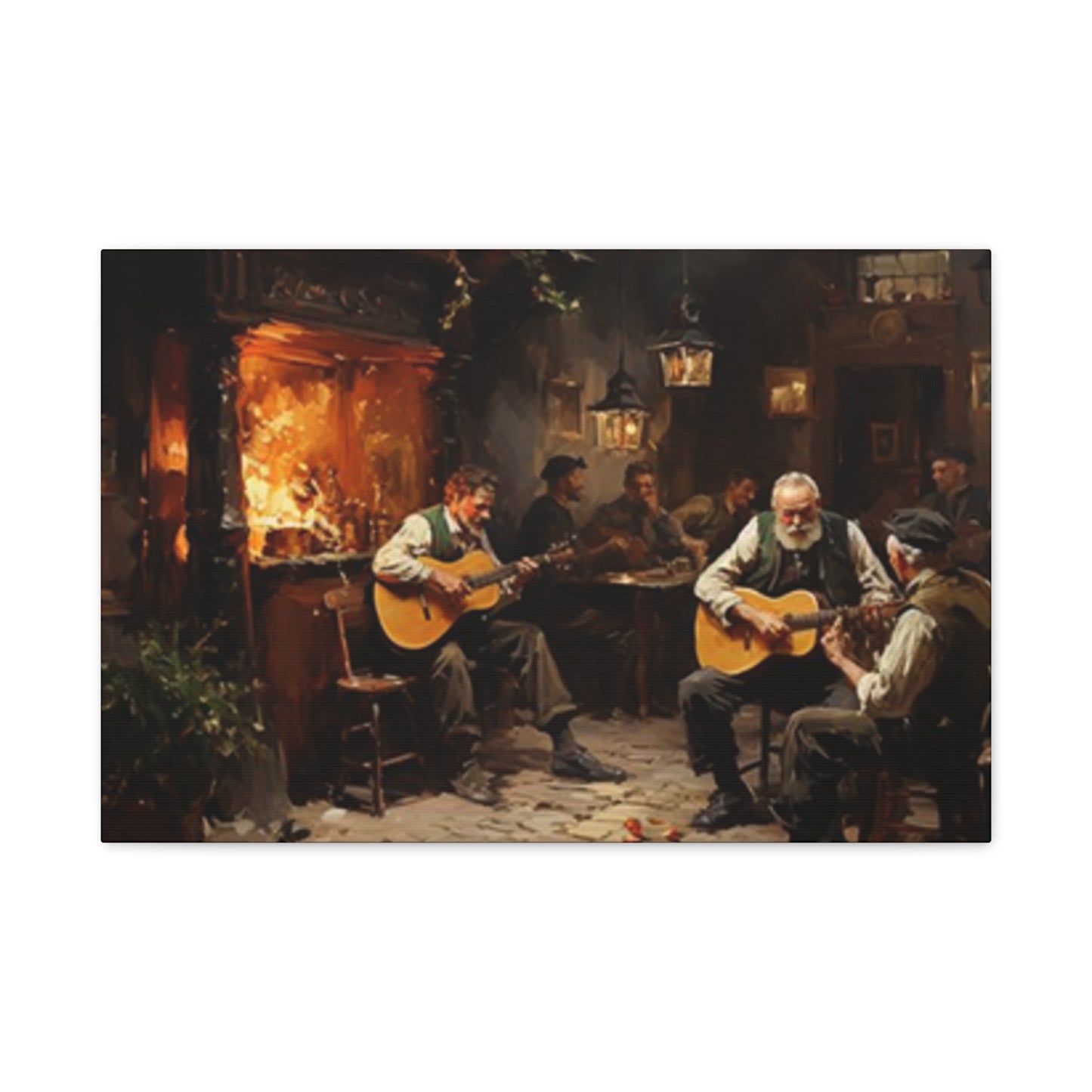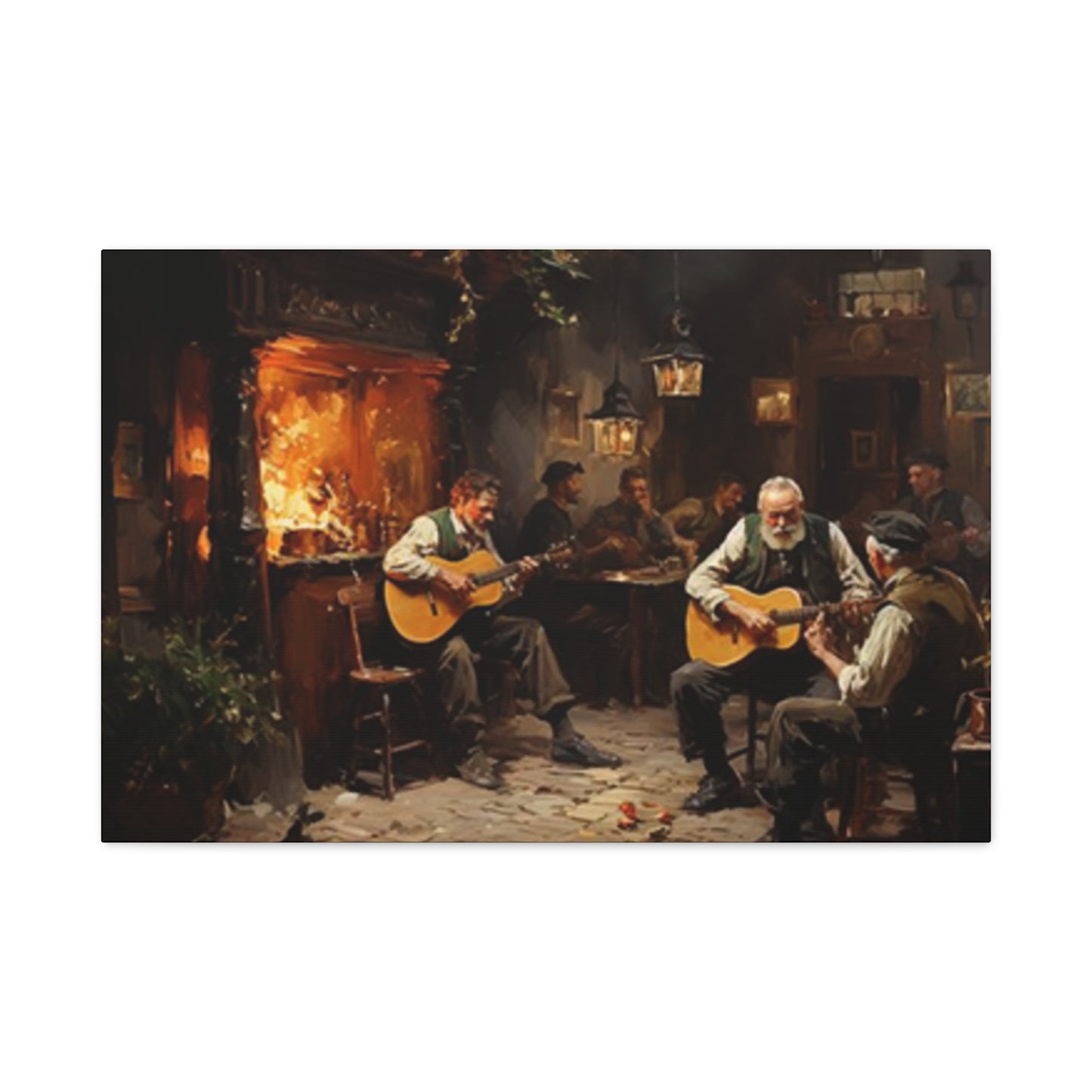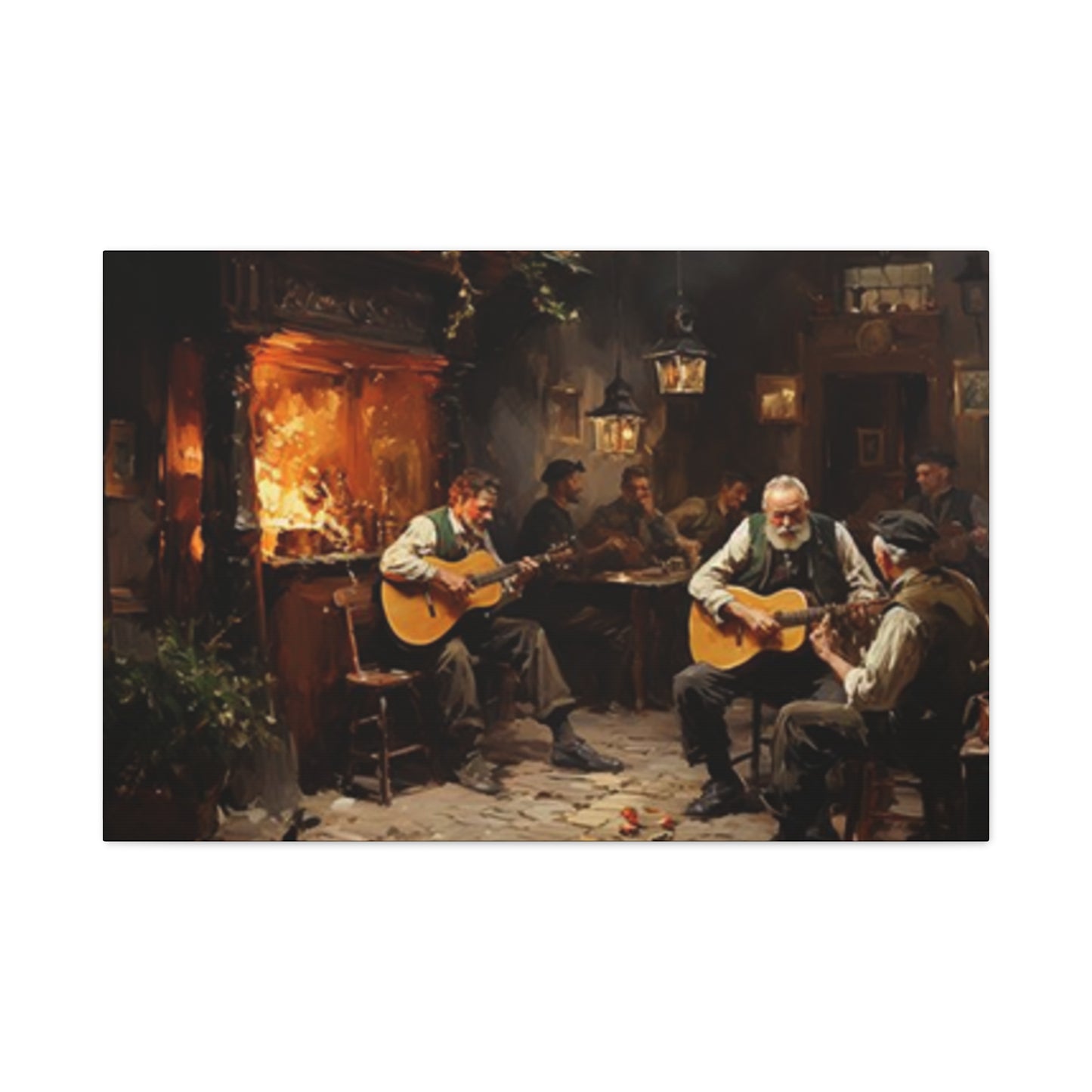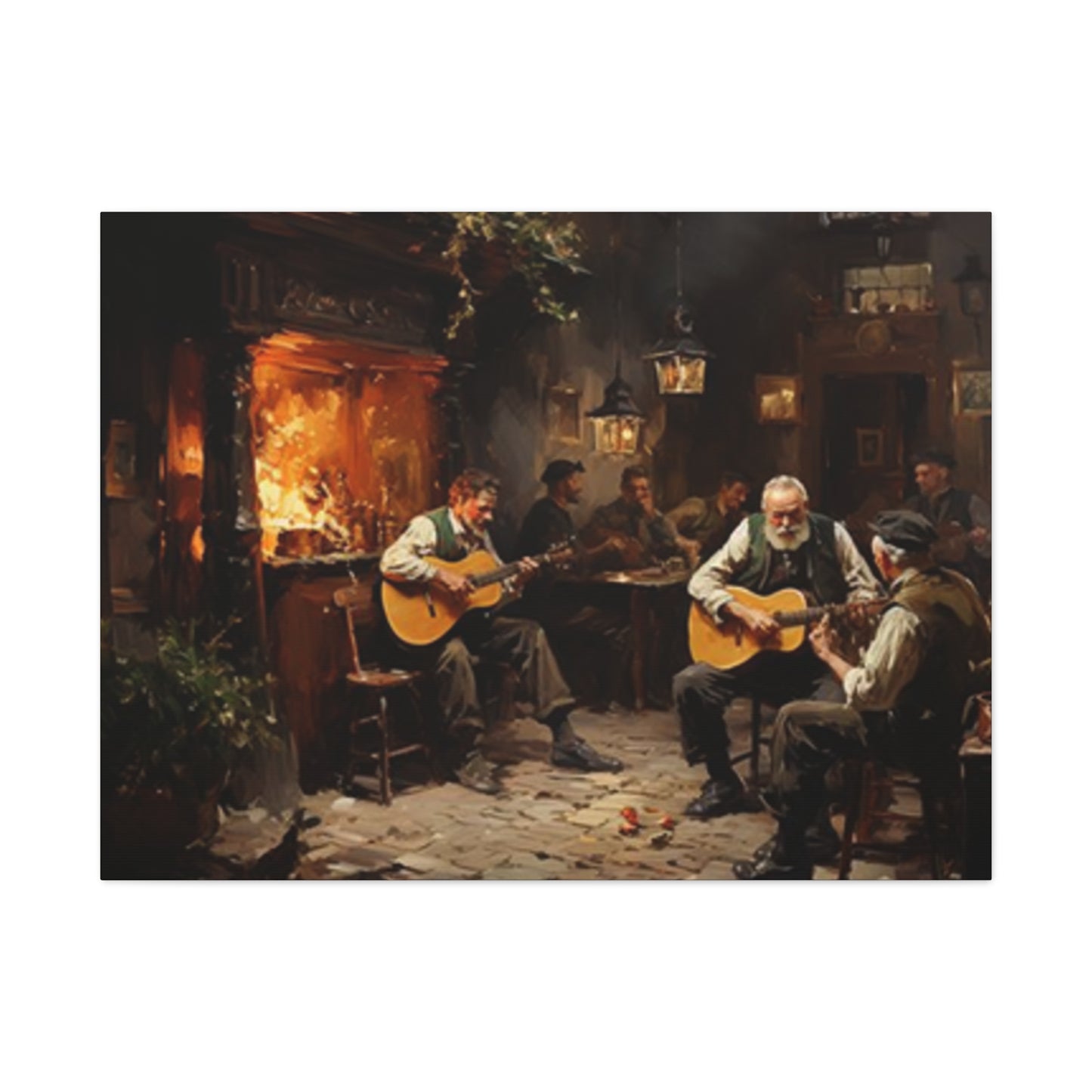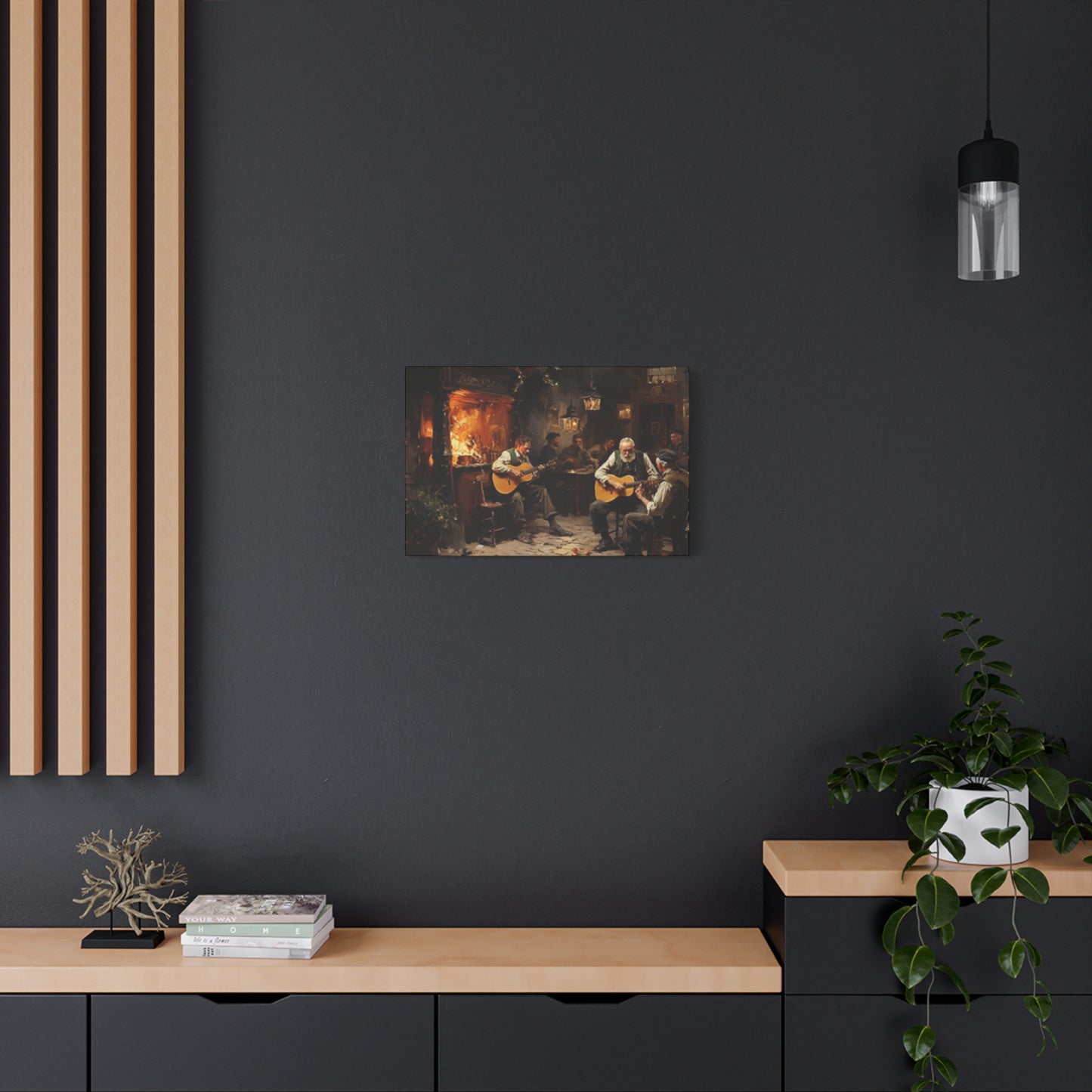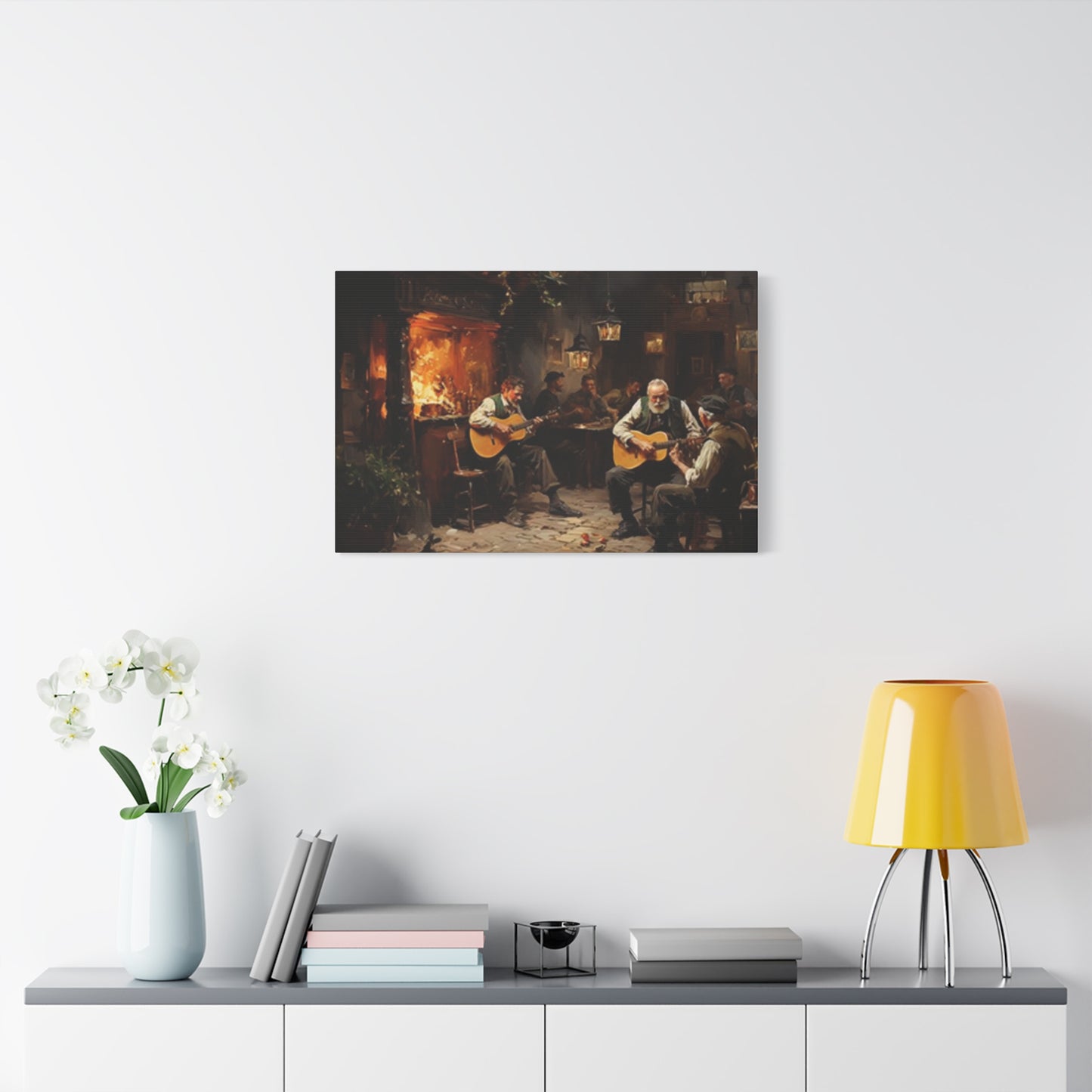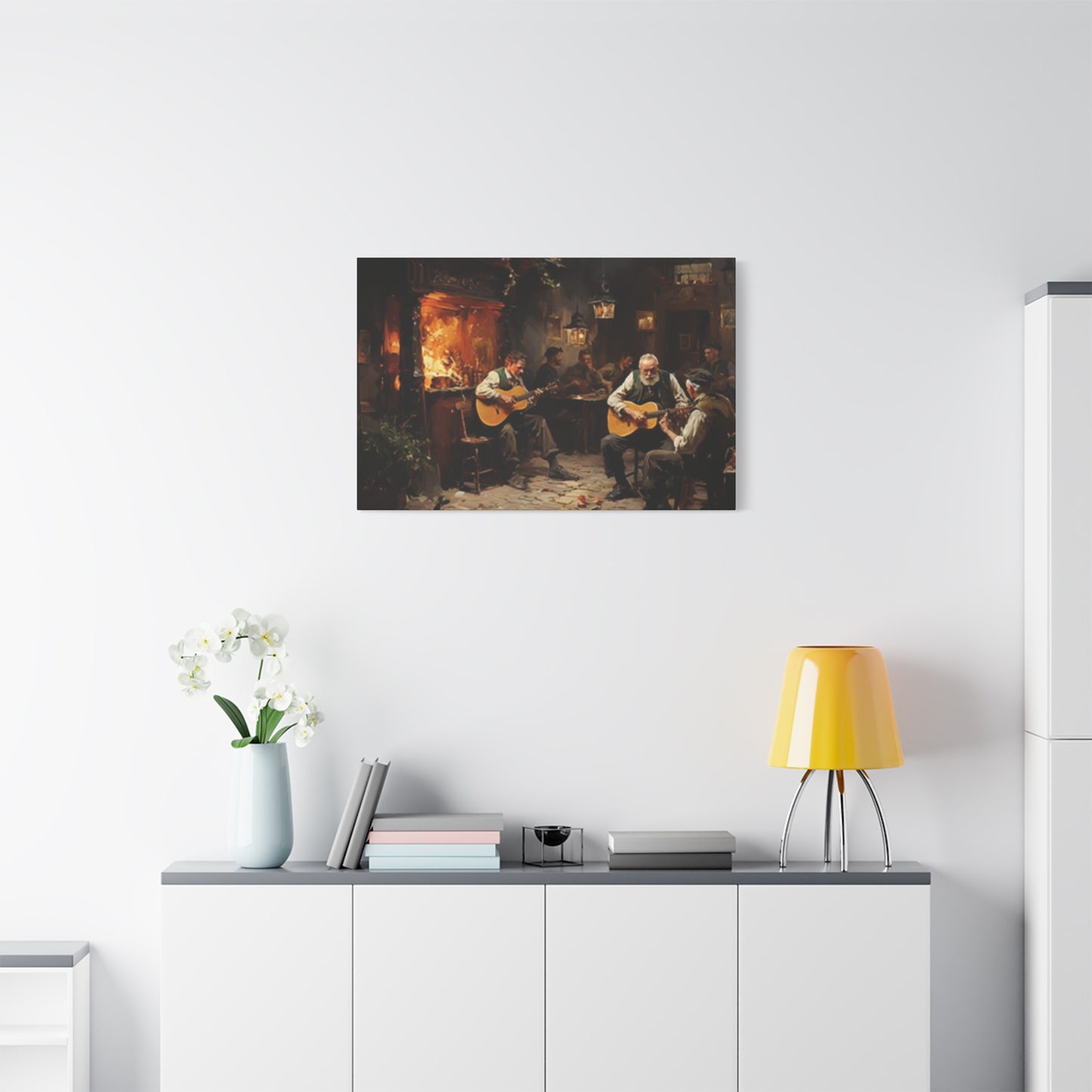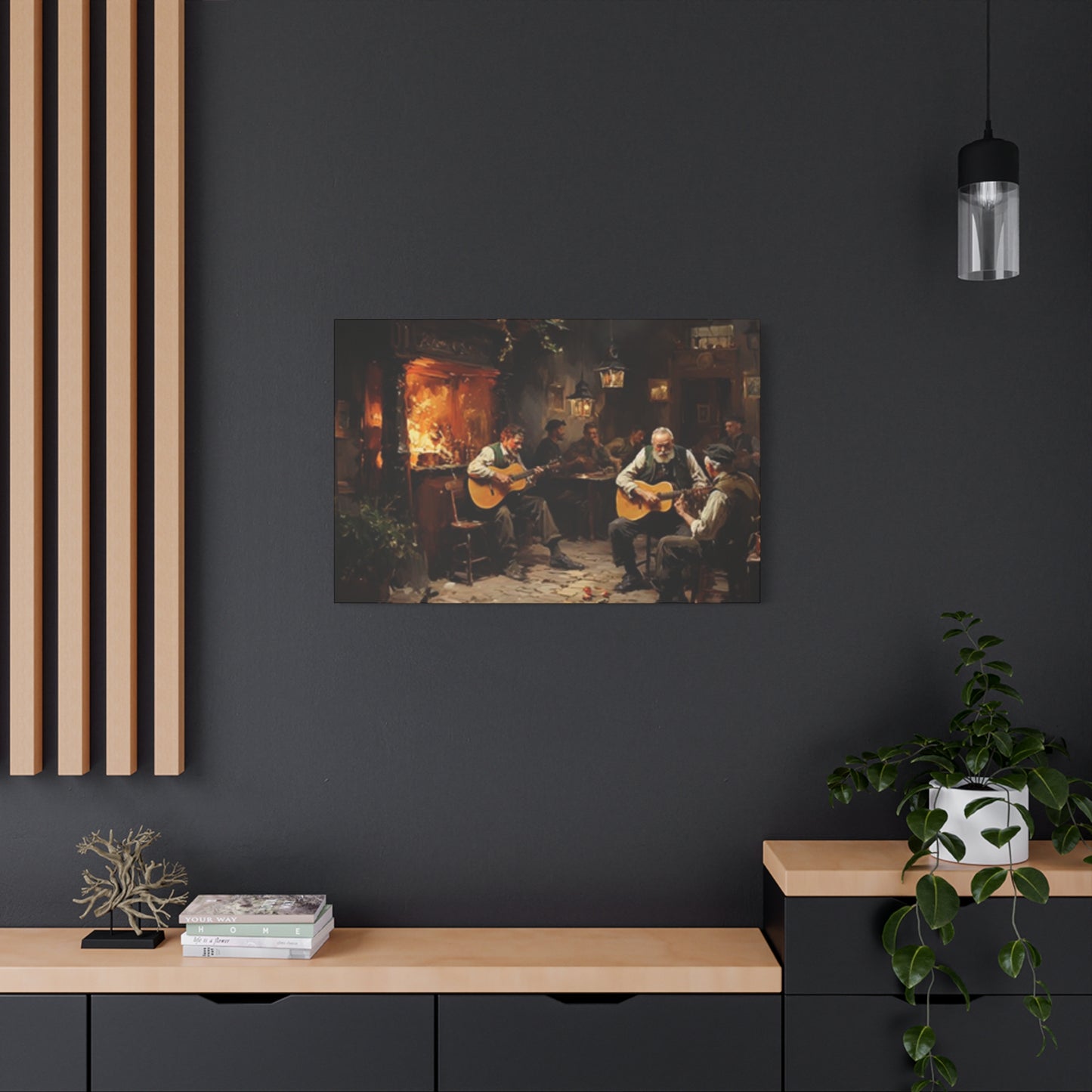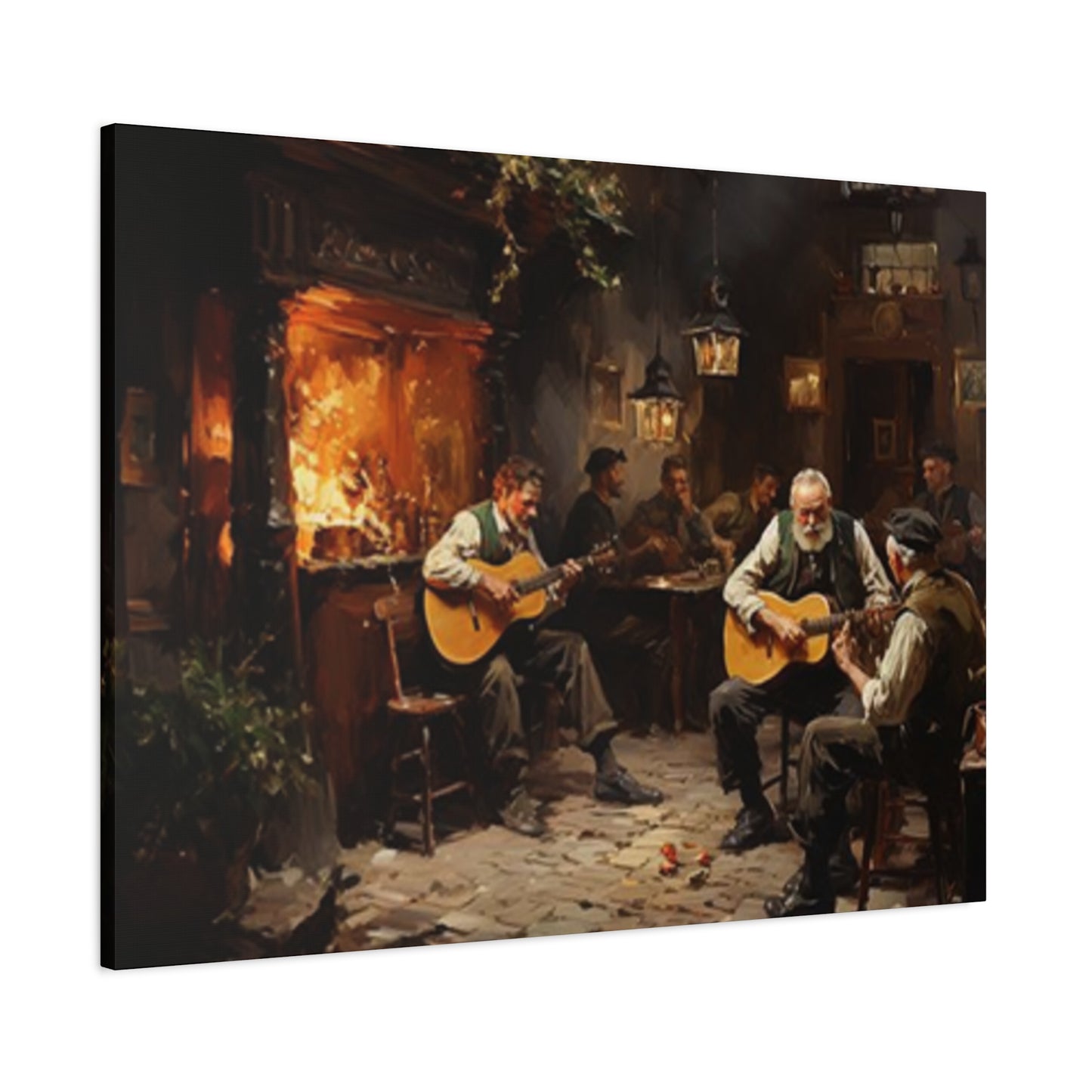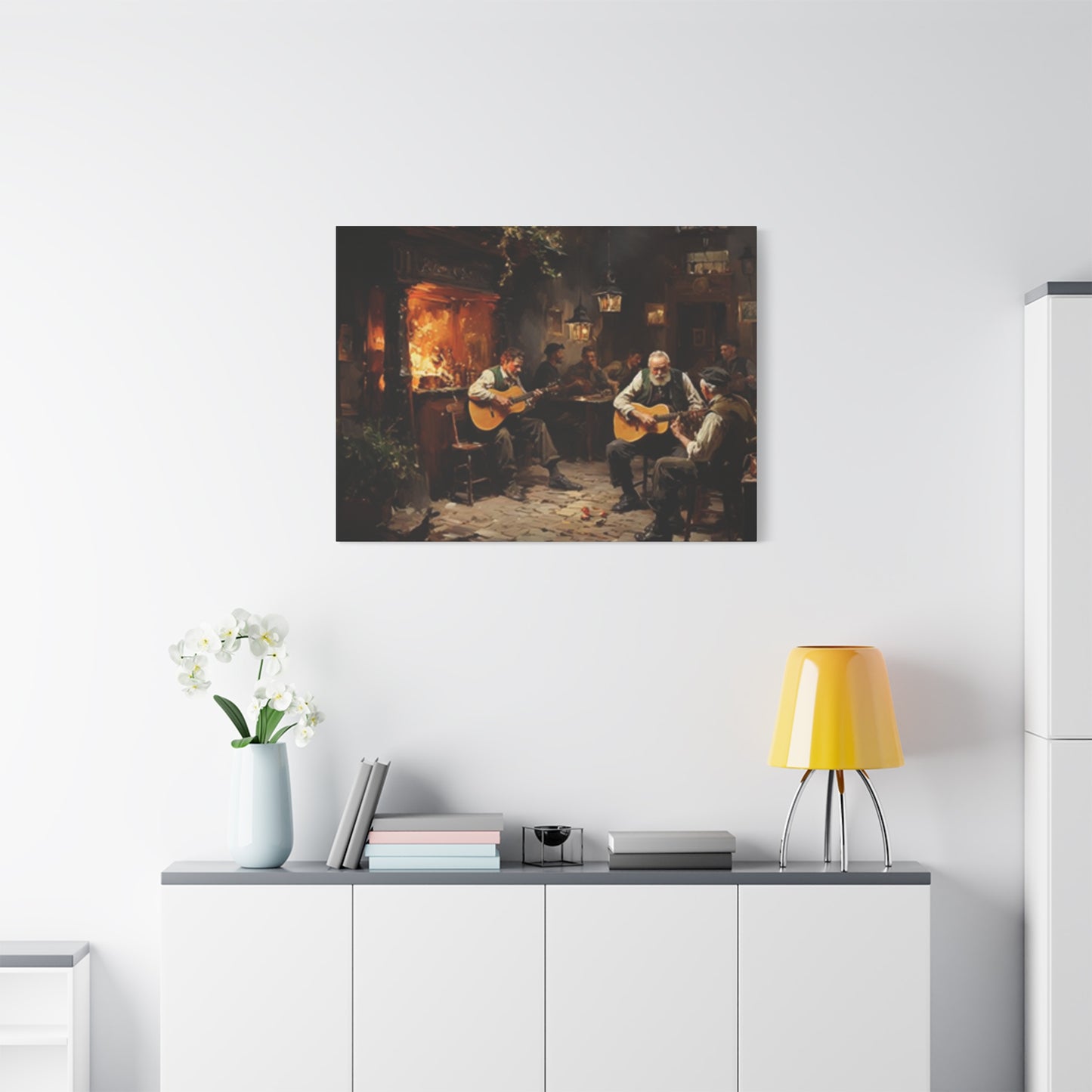Pub and Bar Painting Wall Art: Elevating Your Establishment's Atmosphere and Aesthetic Appeal
The atmosphere within a pub or bar establishment plays an instrumental role in determining whether patrons return for repeat visits. While many business owners focus heavily on beverage selection, food offerings, and service quality, they often overlook one of the most impactful elements that shapes customer experience: the visual environment. Wall art canvas prints have emerged as a powerful tool for transforming ordinary drinking establishments into memorable social spaces that customers actively seek out. The strategic placement of carefully selected canvas artwork throughout a pub or bar can dramatically influence how patrons perceive the space, the duration of their stay, and their likelihood of recommending the venue to friends and colleagues. When customers enter a pub adorned with thoughtfully curated canvas prints, they experience an immediate emotional response that sets the tone for their entire visit. This psychological impact extends far beyond mere decoration, as art pieces serve as conversation starters, mood setters, and brand ambassadors for the establishment itself.
The investment in quality pub and bar wall art canvas prints represents much more than an aesthetic choice. It demonstrates a commitment to creating a sophisticated and welcoming environment that respects customers' desire for more than just alcoholic beverages. Modern patrons increasingly seek out establishments that offer a complete sensory experience, and visual elements are integral to this expectation. A thoughtfully decorated pub with excellent canvas artwork communicates professionalism, attention to detail, and an understanding of what makes a venue special. The texture, color, and subject matter of canvas prints work together to create an immersive environment that encourages customers to linger longer, spend more money on drinks and food, and develop emotional attachments to the location.
Selecting Canvas Artwork That Resonates with Your Establishment's Identity
Every pub and bar possesses its own unique character and identity, whether intentionally cultivated or organically developed through years of operation. When selecting wall art canvas prints for your establishment, it is essential to ensure that the chosen pieces align with and enhance this existing identity rather than contradict or diminish it. A craft beer tavern with an industrial aesthetic will benefit from markedly different canvas selections compared to an upscale cocktail lounge or a neighborhood sports bar. The process of selecting appropriate pub and bar wall art canvas prints requires careful consideration of multiple factors including the establishment's target demographic, its historical context, the overall design theme, and the emotions you wish to evoke in your patrons.
Beginning with demographic analysis provides valuable insights into the types of canvas artwork most likely to resonate with your customer base. A university area pub might feature canvas prints celebrating academic achievement, local sports teams, or vibrant abstract designs that appeal to younger clientele. Conversely, an upscale establishment catering to professionals might showcase more refined canvas artwork featuring classical themes, nature scenes, or sophisticated abstract compositions. Understanding your audience allows you to make informed decisions about color palettes, subject matter, and artistic styles that will appeal to the people who frequent your venue most regularly.
The historical and cultural context of your pub and bar should also influence your canvas print selections. If your establishment has deep roots in a particular community or cultural tradition, incorporating canvas artwork that celebrates this heritage creates authenticity and strengthens connections with long-time patrons. A traditional Irish pub benefits from canvas prints featuring Celtic imagery, Irish landscapes, or historical references to Irish culture and heritage. Similarly, a Mexican cantina can feature canvas artwork celebrating Mexican art traditions, iconic landmarks, or vibrant cultural imagery. This thoughtful integration of culturally relevant canvas prints demonstrates respect for your customer base and creates a cohesive narrative throughout the establishment.
The overall design theme of your pub or bar sets the foundation for all decorative decisions, including canvas print selections. Whether your establishment embraces rustic charm, modern minimalism, vintage nostalgia, or contemporary sophistication, the wall art canvas prints should complement and reinforce this chosen aesthetic. A steampunk-themed pub might feature canvas prints with industrial imagery, mechanical themes, and sepia-toned artwork. A retro-themed bar could showcase canvas prints from classic advertising, vintage posters reproduced on canvas, or nostalgic cultural references from past decades. Consistency in design theme creates a cohesive visual narrative that makes patrons feel they have entered a deliberately crafted environment rather than a space decorated haphazardly over time.
Thematic Consistency and Narrative Development Through Canvas Artwork
Successful pub and bar environments tell coherent visual stories through carefully selected canvas prints that work together to reinforce overarching themes and narratives. Rather than treating individual canvas prints as isolated decorative elements, viewing them as components of a larger narrative framework creates deeper aesthetic cohesion and more memorable customer experiences. A sports bar might develop a narrative celebrating athletic achievement, team loyalty, and competitive spirit through canvas prints depicting iconic sports moments, legendary athletes, and championship celebrations. Each canvas print contributes to this central narrative while individual pieces maintain sufficient visual distinctiveness to create variety and visual interest.
Thematic consistency does not require that every canvas print explicitly reference the establishment's primary theme. Instead, it requires that all artwork chosen shares underlying design principles, color palettes, or emotional tones that create visual unity. A craft brewery might feature canvas prints depicting hops, grain, fermentation equipment, and brewery scenes alongside more abstract artwork and landscapes, with each piece connected through earthy color palettes and artisanal aesthetic sensibilities. This approach to thematic consistency maintains coherence while allowing diversity in subject matter and artistic style. The underlying connections between canvas prints create a sense that decorative choices were deliberate and thoughtfully curated rather than randomly assembled.
Creating distinct visual zones within larger pub and bar environments through thematic canvas selections allows establishments to offer varied atmospheres within single locations. The main bar area might feature energetic, vibrant canvas prints encouraging social interaction, while quieter lounge seating areas could display calming, introspective artwork. Transitional spaces between zones can feature canvas prints incorporating elements from both adjacent areas, creating visual bridges that unify distinct environments. This zoning approach allows patrons to select environments matching their current emotional states and social needs, increasing overall satisfaction and encouraging longer stays.
Seasonal rotation of canvas prints maintains visual freshness while creating reasons for regular patrons to revisit the establishment. Replacing select canvas prints seasonally demonstrates ongoing investment in the environment and prevents aesthetic stagnation that develops when decorative elements remain unchanged indefinitely. Seasonal canvas selections might incorporate holiday imagery during festive periods, nature-based artwork during spring and summer, or warmer-toned pieces during autumn and winter. Announcing seasonal canvas changes through social media or in-establishment communications transforms these updates into events that generate excitement and encourage patrons to revisit venues to experience new visual elements.
Special occasion canvas displays create memorable experiences and strengthen emotional connections between patrons and establishments. Temporarily featuring canvas prints celebrating particular holidays, commemorating historic events, or honoring cultural traditions demonstrates responsiveness to customer interests and community values. A pub might display canvas artwork celebrating Pride Month, featuring LGBTQ+ artistic expressions and cultural imagery. Similarly, establishments might feature canvas prints honoring military service members, celebrating local sports achievements, or recognizing important historical anniversaries. These temporary displays signal that the establishment values community participation and desires to celebrate patron identities and interests.
Sourcing Quality Canvas Prints and Working with Artists and Suppliers
The quality of canvas prints profoundly influences how patrons perceive your establishment, making supplier selection a critical decision extending far beyond simple cost considerations. Establishing relationships with reputable suppliers, galleries, and artists ensures access to quality materials, professional craftsmanship, and artwork selections reflecting your establishment's standards and values. Local artists offer valuable opportunities for sourcing unique, one-of-a-kind canvas pieces that support community creative endeavors while providing distinctive artwork unavailable through mass production channels. Building relationships with local artists creates compelling stories about your establishment's contributions to community cultural life, strengthening patron loyalty and creating marketing opportunities.
Professional canvas reproduction services provide high-quality digital reproductions of famous artworks, allowing establishments to feature iconic pieces and recognizable imagery at reasonable costs. These services employ sophisticated printing technologies and archival-quality materials ensuring that reproduced canvas artwork maintains color accuracy and durability over extended periods. Digital reproduction services offer significant advantages for establishments desiring specific artworks or coordinated series without undertaking custom commission projects. The breadth of available reproductions through professional services enables establishments to source canvas artwork aligning with virtually any aesthetic vision or thematic requirement.
Custom commission projects with professional artists create completely unique canvas pieces tailored specifically to individual establishments' needs and preferences. A pub might commission a canvas portrait of the establishment's founder, custom paintings depicting neighborhood landmarks, or artistic representations of the venue's most popular drinks. Custom commissioned canvases demonstrate significant investment in the venue and create compelling origin stories that enhance patron connections to the space. However, custom commissions require clear communication with artists about vision, timeline, and budget to ensure results meeting expectations. The most successful custom commission projects begin with detailed consultations establishing shared understanding between venue owners and artists regarding creative direction and intended outcomes.
Auction houses and antique dealers provide access to vintage canvas pieces and historical artwork bringing authenticity and character to established establishments. An old pub might feature vintage canvas prints reflecting the aesthetic period when the establishment originally opened, creating visual narratives about the venue's history and evolution. Antique canvas sources also provide unique opportunities for acquiring genuinely valuable artistic pieces that appreciate over time while simultaneously enhancing establishment aesthetics. However, purchasing antique or vintage canvas pieces requires knowledge about condition, authenticity, and fair market pricing to ensure investments represent genuine value.
Online retailers and marketplaces have democratized canvas print sourcing, offering establishments access to vast selection at competitive prices. Platforms facilitating artist-to-consumer connections allow establishments to discover emerging artists and unique perspectives unavailable through traditional gallery channels. However, online purchasing requires caution regarding quality assurance, return policies, and vendor reliability. Establishing relationships with online sellers known for consistent quality and reliable service reduces risk associated with remote purchasing. Reading detailed product reviews, examining high-resolution imagery, and understanding return policies mitigates potential disappointments with online canvas purchases.
Lighting Design That Showcases Canvas Artwork to Maximum Advantage
The lighting environment surrounding canvas prints fundamentally influences how viewers perceive artwork, experience colors, and emotionally respond to displayed pieces. Professional lighting design specifically for canvas artwork enhances visual appeal, emphasizes artistic details, and creates atmospheres that support overall establishment aesthetic objectives. Strategic lighting transforms ordinary canvas prints into visual focal points that command attention and create memorable impressions on patrons. Understanding lighting principles specific to canvas display enables establishments to maximize their investments in quality artwork through thoughtful illumination design.
Accent lighting directed specifically at canvas prints creates visual emphasis that distinguishes artwork from surrounding environments and draws viewer attention. Track lighting, picture lights, and wall wash systems allow precise control over which areas receive illumination and how intensely light strikes canvas surfaces. Professional accent lighting typically involves placing light sources at angles preventing direct glare while uniformly illuminating canvas surfaces. The angle of light impact significantly influences how viewers perceive artistic details and colors, with certain angles emphasizing texture and dimensionality while others flatten and diminish artwork appearance. Most professional lighting designers recommend positioning lights at angles between thirty and forty-five degrees from canvas surfaces for optimal detail visibility and color presentation.
Color temperature of lighting sources influences how canvas colors appear to patrons, making this technical consideration essential for achieving desired visual effects. Warm color temperature lighting between three thousand and four thousand Kelvin flatters canvas prints with warm palettes and creates intimate, welcoming atmospheres. Cool color temperature lighting ranging from five thousand to six thousand Kelvin emphasizes canvas artwork with blue and green tones while creating contemporary, sophisticated visual presentations. Many successful establishments employ lighting combining multiple color temperatures to create visual complexity and allow different canvas pieces to display optimally under varying light conditions.
Natural light integration, where available, provides authentic illumination that displays canvas artwork under conditions closely resembling gallery environments. Establishments featuring windows and natural light benefit from strategic canvas placement that exploits natural illumination during daytime hours. However, direct sunlight can fade canvas artwork over extended periods, requiring UV-protective glazing or strategic positioning away from direct sun exposure. Many establishments employ programmable lighting systems that adjust artificial lighting intensity and color temperature throughout the day, mimicking natural light transitions and maintaining optimal canvas appearance under all lighting conditions.
Ambient lighting throughout the establishment should coordinate with canvas-specific accent lighting to create cohesive visual environments. Overly bright ambient lighting can overwhelm canvas artwork and diminish artistic impact, while insufficiently bright ambient lighting can create underlit, gloomy atmospheres that discourage socializing. Most successful pub and bar establishments employ layered lighting systems featuring bright enough ambient illumination for comfortable navigation and social interaction, complemented by enhanced accent lighting on featured canvas artwork. This layered approach creates visual hierarchy emphasizing artistic elements while maintaining practical illumination for patron safety and comfort.
Maintenance and Preservation of Canvas Artwork Investment
Canvas prints represent significant investments in establishment aesthetics, making proper maintenance and preservation practices essential for protecting these investments and maintaining visual appeal over extended periods. Canvas material, though durable, requires appropriate environmental conditions and handling to prevent deterioration, fading, and damage. Understanding and implementing proper maintenance practices ensures that canvas artwork continues enhancing establishment appeal years after initial installation. Neglected canvas can develop discoloration, dust accumulation, and fading that substantially diminishes aesthetic impact and suggests careless establishment management.
Environmental control significantly influences canvas preservation, requiring establishments to maintain stable temperature and humidity levels preventing material degradation. Extreme temperature fluctuations cause canvas materials to expand and contract, potentially leading to cracking, warping, and separation from stretcher frames. Similarly, excessive humidity can promote mold growth and material deterioration, while insufficient humidity can cause brittleness and cracking. Most conservators recommend maintaining interior environments between sixty and seventy Fahrenheit with relative humidity between forty and fifty-five percent for optimal canvas preservation. Establishments in climates with significant seasonal variations benefit from climate control systems managing temperature and humidity year-round, preventing environmental stress on valuable canvas pieces.
Dust and particulate accumulation on canvas surfaces requires regular gentle cleaning to maintain appearance and prevent material degradation. A soft-bristled brush or microfiber cloth gently swept across canvas surfaces removes surface dust without disturbing paint or protective coatings. More thorough cleaning might employ specialized canvas cleaning solutions applied with appropriate techniques, though establishments should consult conservation specialists before applying any chemical products to valuable artwork. Professional conservation cleaning, while expensive, becomes necessary for high-value canvas pieces or artwork showing visible soiling and deterioration requiring expert intervention.
Direct sunlight exposure represents a primary threat to canvas longevity, causing fading and material deterioration over extended periods. Canvas prints and artwork should be positioned away from direct windows and sunlight exposure whenever possible. For canvas necessarily positioned in areas receiving some natural light, UV-protective window treatments can filter harmful radiation while maintaining visible light transmission. Some establishments employ UV-protective glazing or varnishes applied to canvas surfaces, providing additional protection against light-induced fading. However, protective coatings must be applied skillfully to avoid diminishing artwork appearance or creating unwanted reflections.
Pest management prevents insect damage to canvas materials and framing components. Canvas provides attractive environments for certain insects and rodents seeking shelter and food sources. Regular pest control inspections and preventive treatments protect canvas artwork from damage requiring expensive restoration. Maintaining clean environments around canvas displays, avoiding food storage near artwork, and addressing pest problems promptly prevents infestations that could compromise valuable pieces.
Physical protection from impact damage requires thoughtful placement considerations and occasional protective barriers for canvas in high-traffic areas or establishments where patron crowding occurs. Canvas positioned behind bars or in restricted areas face minimal impact risk, while canvas in open areas might require protective barriers or repositioning away from potential damage sources. Some establishments employ plexiglass or acrylic protective glazing over valuable canvas pieces, providing physical protection while maintaining artwork visibility. The decision to use protective glazing represents a balance between preservation objectives and aesthetic considerations, with some establishments accepting minimal risk in exchange for unobstructed artwork visibility.
Economic Impact and Return on Investment from Canvas Print Installations
The financial implications of investing in quality pub and bar wall art canvas prints extend beyond simple decoration costs, influencing patron spending patterns, establishment reputation, and long-term business success. Research into commercial interior design demonstrates that establishments featuring thoughtfully curated artwork experience measurably higher revenue compared to similar venues with minimal or careless decoration. The relationship between aesthetic quality and patron spending suggests that quality canvas prints represent legitimate business investments rather than mere discretionary expenses. Understanding these economic relationships enables establishment owners to make informed decisions about canvas artwork budgets and justify investments through anticipated returns.
Studies examining patron behavior in hospitality establishments reveal that customers perceive venues with quality artwork as more upscale and worthy of premium pricing than similar establishments with minimal decoration. This perception premium allows canvas-displaying establishments to charge higher prices for identical beverages and food items, capturing additional revenue from customer willingness to pay for superior atmospheres. The reputation enhancement resulting from quality canvas displays attracts customers willing to travel greater distances and spend more freely within establishments known for exceptional aesthetics. Social media amplification of establishments with distinctive canvas artwork creates marketing benefits extending far beyond the immediate customer base, as patrons photograph and share images of memorable artwork, generating organic promotional content.
Patron dwell time represents another crucial economic metric influenced by environmental quality including canvas artwork. Establishments featuring engaging, high-quality canvas displays experience longer average patron stays compared to venues with minimal decoration. Extended dwell times directly translate to increased consumption of beverages and snacks, as customers ordering additional items while remaining on premises generate higher per-patron revenue. The engagement created by quality canvas artwork encourages patrons to linger, socialize, and spend more time within the establishment than they might in less carefully decorated venues. This extended stay duration represents one of the most significant economic benefits of quality canvas print investments.
Customer retention and repeat visitation patterns correlate strongly with overall establishment aesthetics including canvas artwork quality and curation. Patrons forming emotional attachments to establishments through memorable visual experiences demonstrate higher loyalty and return visit frequencies compared to customers perceiving venues as forgettable or interchangeable. The distinctive visual identity created through thoughtfully selected canvas prints makes establishments memorable and worth recommending to friends and colleagues. These referral benefits generate word-of-mouth marketing advantages that reduce customer acquisition costs and build sustainable growth through reputation enhancement. Establishments recognized for distinctive canvas artwork build brand equity that persists across years of operation and survives competitive pressure from new entrants.
Risk mitigation through aesthetic differentiation protects establishments against market competition and economic downturns. During economic downturns when discretionary spending decreases, establishments offering superior experiences maintain patron loyalty and spending levels better than venues perceived as commoditized or mediocre. The emotional connections and memorable experiences created through quality canvas displays provide competitive advantages that transcend price competition. Establishments competing primarily on price face vulnerability to lower-cost competitors, while venues differentiated through distinctive atmospheres and superior customer experiences maintain pricing power and customer loyalty independent of direct price comparisons.
Creating Instagram-Worthy Spaces That Drive Social Media Engagement
Contemporary pub and bar marketing increasingly leverages social media sharing, making visually striking environments essential components of modern promotional strategies. Canvas artwork selections should explicitly consider photographic appeal and likelihood of patron social media sharing. Establishments featuring visually distinctive, photographically interesting canvas artwork generate organic social media content as patrons photograph artwork and share images through social networks. This user-generated content provides authentic promotional materials more credible and effective than traditional advertising while reaching audiences through trusted peer recommendations. Designing spaces specifically for social media appeal represents a modern marketing imperative that complements rather than contradicts authentic aesthetic curation.
Large-scale, visually striking canvas prints work particularly well for social media optimization, as they photograph clearly and create compelling backdrops for patron selfies and group photos. Vibrant colors photograph well under various lighting conditions, while subtle or muted tones may fail to translate effectively through smartphone camera sensors. Positioning focal canvas artwork in locations where patrons naturally position themselves for photographs ensures maximum social media exposure. Many establishments designate specific areas or walls as photo-worthy spaces, positioning outstanding canvas artwork as deliberate backdrops for patron photography. The strategic placement of canvas artwork considering sight lines and photographic angles maximizes likelihood of social media appearance and organic promotional benefits.
Hashtag strategies leveraging distinctive canvas artwork create trackable social media campaigns amplifying organic reach and engagement. Establishments might encourage patrons to share photos with venue-specific hashtags, making shared content discoverable by potential customers browsing social platforms. Creating Instagram guides featuring locations of distinctive canvas artwork throughout the establishment encourages patrons to explore the space while generating multiple social media touchpoints. Limited-edition or temporary canvas installations create seasonal interest and encourage repeat visits as patrons return to photograph new artwork before it rotates. These strategic social media considerations integrate seamlessly with aesthetic curation, ensuring that canvas selections serve dual purposes of genuine aesthetic enhancement and modern marketing functionality.
Collaborative social media features with artists creating custom canvases amplify both the artwork's promotional value and the artist's exposure. Establishments might feature artist takeovers on social media, behind-the-scenes content about canvas creation and installation, or artist interviews and features. These collaborative approaches build community around canvas artwork while extending social media reach through shared promotion between establishments and creative professionals. Patrons following featured artists receive updates about new work locations, encouraging them to visit establishments showcasing particular artists' work. The intersection between authentic artistic collaboration and social media strategy creates powerful synergies that benefit all stakeholders.
Diversity and Inclusion Through Canvas Art Representations
Contemporary pub and bar environments increasingly prioritize diversity and inclusion, leveraging canvas artwork as tools for communicating values and creating welcoming environments for patrons from diverse backgrounds and identities. Canvas prints celebrating diverse cultural traditions, artistic styles, and perspectives demonstrate commitment to inclusive environments valuing all community members. Establishments featuring canvas artwork celebrating LGBTQ+ artists and themes, racial and ethnic diversity, gender representation, and cultural traditions explicitly communicate that all patrons are welcome and valued. This explicit inclusion through artistic choices builds community among marginalized populations while signaling to all patrons that the establishment prioritizes social values beyond simple profit maximization.
Representation in canvas artwork extends beyond symbolic gestures to substantive curation reflecting genuine commitment to diversity and inclusion. Featuring canvas prints created by artists from underrepresented groups supports marginalized creative professionals while bringing authentic diverse perspectives to establishment aesthetics. Commissioning canvas artwork specifically celebrating particular communities or cultural traditions demonstrates investment in inclusive representation rather than superficial diversity tokens. These substantive approaches to diversity through canvas artwork build deeper community connections and authentic commitment to inclusive values. Patrons recognizing genuine diversity commitments demonstrate stronger loyalty and positive word-of-mouth promotion compared to responses to perceived tokenistic diversity efforts.
Educational components accompanying diverse canvas artwork enhance patron understanding and appreciation while providing valuable context. Displaying informational cards near canvas artwork explaining artist backgrounds, cultural contexts, or thematic significance deepens patron engagement and transforms canvas displays into educational experiences. Establishments might host artist talks, cultural celebration events, or educational programming connected to featured canvas artwork, creating community engagement opportunities extending beyond passive viewing. These educational components transform canvas artwork from decorative elements into platforms for meaningful community dialogue and cultural exchange.
Seasonal and Rotating Canvas Displays Maintaining Visual Freshness
Static canvas displays risk becoming invisible over time as patrons cease consciously perceiving familiar environmental elements through habituation processes. Strategic rotation of canvas artwork maintains visual interest and creates reasons for repeat patrons to notice new visual elements during subsequent visits. Seasonal rotations aligned with natural cycles and cultural holidays provide logical frameworks for canvas replacement that feel intentional and thematic rather than arbitrary. Announcing canvas rotations through social media, in-establishment signage, and word-of-mouth marketing transforms routine decorative updates into events generating excitement and encouraging patron visitation.
Quarterly canvas rotations represent a practical balance between maintaining freshness and reducing maintenance burden associated with frequent replacements. Spring rotations might feature vibrant, nature-inspired canvas artwork celebrating renewal and new growth. Summer displays could showcase brighter colors and outdoor-themed imagery evoking vacation atmospheres. Autumn rotations introduce warmer tones and harvest imagery reflecting seasonal environmental changes. Winter displays might feature festive holiday themes or cozy interior scenes encouraging patrons to seek warm pub environments. These seasonal rotations feel natural and inevitable rather than requiring deliberate decision-making about rotation timing.
Thematic series featuring multiple canvas artworks exploring particular topics or artistic styles create coherent rotating displays that maintain continuity while introducing novelty. A pub might feature series dedicated to particular artistic movements, celebrated artists, or cultural traditions, rotating through different series throughout the year. This approach to canvas rotation maintains thematic unity while allowing significant visual changes between rotation periods. Patrons might anticipate particular series and plan visits specifically to experience featured artworks, building seasonal engagement patterns that increase frequency of patronage.
Limited edition or time-limited canvas displays create urgency encouraging patron visitation before featured artwork rotates. Announcing that particular canvas displays will only remain on display for specific time periods motivates patrons to visit within limited windows, driving traffic during specific periods. This approach leverages psychological principles of scarcity and urgency, encouraging attendance that might not occur without artificial time constraints. Special displays around major holidays, cultural celebrations, or venue anniversaries can feature time-limited canvas artwork creating memorable occasion associations.
Community Engagement and Local Artist Partnerships
Featuring local artists' work through canvas displays creates reciprocal community relationships that benefit both establishments and creative professionals. Local artists gain exhibition opportunities and audience exposure while establishments obtain unique artwork supporting community cultural development. Partnership approaches might include permanent gallery walls dedicated to rotating local artists, commission arrangements for custom canvas work, or consignment arrangements where artists maintain partial ownership and revenue participation. These collaborative models create shared investments in establishment success while building community connections extending beyond simple commercial transactions.
Gallery nights and exhibition openings centered around canvas artwork featured within establishments create community gathering opportunities and cultural events attracting new patrons. Hosting artist receptions, exhibition opening celebrations, or artist talk events transforms canvas displays into social occasions bringing community members together. These events generate local media coverage, social media promotion, and word-of-mouth marketing while supporting local artistic communities. Patrons attending gallery events often purchase beverages and food, converting cultural programming into revenue while contributing to community cultural vitality. The reputation enhancement from arts patronage attracts culturally engaged customers valuing establishments contributing to community creative development.
Artist residency programs, though relatively uncommon in pub environments, create intensive collaboration opportunities where artists work within establishments while developing new work. Artist residencies might involve visual artists creating artwork directly within the pub space, musicians developing compositions inspired by the establishment atmosphere, or poets writing works celebrating the venue. These intensive collaborations generate unique content while creating compelling stories about establishment-artist relationships. Patron interactions with resident artists create memorable experiences and opportunities for genuine human connection extending beyond typical bartender-customer dynamics.
Community art classes and workshops utilizing canvas and establishment space for instruction create value-added programming that differentiates venues while supporting community artistic development. Evening watercolor classes, painting workshops, or artistic technique instruction sessions transform underutilized space into community resources. Participants naturally consume beverages and food while attending classes, generating revenue from programming. Successful community art programming builds loyal customer bases among arts-engaged demographics while creating positive community relationships that benefit business operations and reputation.
Addressing Budget Constraints While Maintaining Aesthetic Excellence
Establishments operating under budget constraints need not compromise on canvas artwork quality through strategic sourcing, collaborative relationships, and creative curation approaches. Cost-effective alternatives to expensive gallery pieces include working with emerging artists offering reasonable commission rates, sourcing quality reproductions through affordable online retailers, and acquiring vintage canvases through secondhand markets. Budget-conscious establishments benefit from focusing limited resources on fewer, high-quality focal pieces rather than attempting comprehensive canvas coverage with mediocre artwork. Strategic focal walls featuring exceptional canvas artwork create greater visual impact than scattered mediocre pieces throughout the space.
DIY and community collaboration approaches reduce costs while building community investment in establishment aesthetics. Art students might contribute work in exchange for exhibition opportunities and portfolio exposure. Community members might donate artwork supporting favorable causes, reducing acquisition costs while strengthening community connections. Staff member artistic talents can be leveraged for creating original canvas artwork, transforming employee skills into valuable aesthetic contributions. These collaborative approaches often generate more authentic and meaningful artwork than purely commercial acquisitions while building emotional investments from community members and staff.
Phased implementation strategies allow establishments to gradually build comprehensive canvas collections without requiring large upfront investments. Beginning with essential focal pieces and gradually expanding collections over months or years spreads costs while allowing learning from initial selections. This phased approach also enables refinement of aesthetic vision as establishments clarify preferences and visual directions. Patrons perceive gradual aesthetic improvement as ongoing investment in venue quality rather than complete transformation, reducing risk of changes seeming inauthentic or disconnected from established character.
Consignment and revenue-sharing arrangements with artists reduce upfront costs while creating income-sharing models aligning incentives. Artists maintaining partial ownership and revenue participation invest in canvas placement within successful establishments, motivating quality work and proper display. These arrangements benefit emerging artists gaining exhibition opportunities while reducing establishment acquisition costs. Revenue-sharing models create sustainable relationships where both parties benefit from establishment success and patron engagement with featured artwork.
Framing, Mounting, and Installation Considerations
The presentation and installation of canvas artwork significantly influences perceived value and aesthetic impact beyond the artwork itself. Canvas mounting systems range from simple wire or frame hangers to elaborate gallery-style display systems. The quality and sophistication of mounting systems should align with artwork quality and establishment aesthetic standards. Budget-conscious installations might employ simple wire hangers adequate for casual environments, while upscale establishments benefit from sophisticated hanging systems emphasizing artwork presentation. Professional installation by experienced framers or display specialists ensures secure, level, and visually appealing canvas positioning.
Framing decisions require balancing artistic presentation objectives with practical establishment considerations. Canvas artwork frequently benefits from frame elements directing viewer attention toward artwork while providing visual definition and separation from surrounding environments. Material selection for frames should complement both canvas artwork and surrounding architectural elements. Natural wood frames work well in rustic or traditional environments, while metal or minimalist frames suit contemporary spaces. The decision whether to employ frames versus direct canvas mounting represents an aesthetic choice with significant visual implications.
Canvas stretching and mounting procedures affect artwork durability and appearance. Professional canvas mounting on wooden stretcher frames ensures proper tension and alignment, preventing sagging or misalignment that diminishes visual appeal. Quality mounting materials resist warping and environmental stress that could damage canvas or compromise structural integrity. Establishments featuring valuable artwork benefit from professional conservation-quality mounting specifications ensuring long-term preservation and reliability.
Wall preparation represents an often-overlooked consideration significantly affecting installation quality and final appearance. Walls should be properly prepared, smoothed, and primed if necessary to provide appropriate surfaces for mounting systems. Surface irregularities visible behind mounted canvas distract from artwork and communicate insufficient attention to installation details. Professional wall preparation ensures optimal installation conditions and maintains visual integrity. Some establishments employ wall protection films or surfaces preventing damage from mount hardware while preserving wall surfaces beneath canvas installations.
The Psychology of Color Combinations in Multi-Canvas Displays
When featuring multiple canvas prints in proximity, color relationships between artworks influence how patrons perceive individual pieces and overall aesthetic environment. Complementary color schemes featuring colors opposite on the color wheel create visual excitement and dynamic energy. A canvas print featuring dominant blues positioned near artwork with dominant oranges creates striking visual contrast that energizes spaces and captures attention. These high-contrast combinations work well in establishments seeking energetic, vibrant atmospheres encouraging social interaction and celebration. However, excessive complementary color combinations can create visually overwhelming environments that exhaust rather than engage patrons.
Analogous color schemes utilizing colors adjacent on the color wheel create visual harmony and sophisticated unity. Canvases featuring blues, blue-greens, and greens positioned together create cohesive visual presentations that feel organized and intentional. Analogous combinations work particularly well in upscale establishments seeking sophisticated, refined atmospheres. The visual harmony created through analogous color relationships calms rather than stimulates, supporting extended engagement and contemplative enjoyment. These harmonious combinations communicate intentional curation and professional design sensibility.
Triadic color combinations featuring three colors equally spaced on the color wheel create balanced, vibrant displays avoiding monotony while maintaining organization. A triadic scheme incorporating reds, yellows, and blues in properly proportioned canvas displays creates dynamic yet organized visual presentations. Triadic combinations require more sophisticated color balance awareness to avoid appearing chaotic, but when properly executed create memorable, distinctive aesthetic environments. These complex color relationships reward patron attention with visual complexity and compositional sophistication.
Monochromatic color schemes utilizing variations of single colors create minimalist, sophisticated presentations emphasizing artwork form and composition rather than color variation. Monochromatic canvases featuring different shades and tones of blue create unified displays with subtle sophistication. These minimal color approaches work well in contemporary, upscale establishments prioritizing refinement over vibrancy. Monochromatic schemes can risk appearing monotonous if insufficient variation exists between displayed pieces, requiring careful curation to maintain interest within limited color palettes.
Corporate Branding and Canvas Artwork Integration
Multi-location establishment chains increasingly utilize consistent canvas artwork strategies reinforcing corporate branding across locations while maintaining local market relevance. Standardized artwork selections create brand consistency customers recognize across different venues. However, complete homogenization risks creating sterile, impersonal environments that fail to connect with local communities. Successful chain establishments balance standardized elements supporting brand consistency with localized curation reflecting community character and patron preferences. Corporate guidelines might specify particular artwork themes, color palettes, or artistic styles while allowing local flexibility in specific piece selection and placement.
Branded canvas artwork featuring establishment logos, slogans, or imagery reinforces corporate identity while transforming promotional materials into sophisticated aesthetic elements. High-quality branded canvases feel less like advertising and more like intentional design choices when professionally executed. Custom canvases incorporating establishment branding with artistic imagery create sophisticated representations of corporate identity. However, excessive branding or poor artistic execution risks transforming canvas displays into crude advertising that diminishes rather than enhances aesthetic environment. The balance between brand reinforcement and artistic merit requires careful execution.
Local market variation through community-specific canvas selections allows establishments to maintain corporate consistency while respecting local cultural contexts and patron preferences. Canvas artwork celebrating local sports teams, community landmarks, or regional artistic traditions maintains corporate identity while demonstrating responsiveness to local communities. This approach to corporate branding balances efficiency advantages of standardization with relationship benefits from localization. Establishments demonstrating understanding of local communities through culturally responsive canvas selections build deeper connections than venues appearing disconnected from local contexts despite corporate quality.
Art Investment and Appreciation Potential
Establishments viewing canvas artwork as potential financial investments rather than pure expenses approach curation differently, considering long-term value appreciation alongside immediate aesthetic benefits. Original artwork by established or emerging artists frequently appreciates in value over time, particularly as artists gain recognition and career development. Institutions featuring work by now-famous artists can eventually sell original canvases at significant multiples of original acquisition costs. This investment potential provides additional justification for acquiring higher-quality original artwork compared to mass-produced reproductions. However, investment returns remain secondary considerations for most establishments where primary value derives from immediate aesthetic and commercial benefits.
Documentation and provenance maintenance become important considerations when viewing artwork as potential investments. Maintaining records about artwork origins, artist information, acquisition dates, and purchase prices supports future valuations and sales. Professional conservation and preservation practices maintain artwork condition supporting long-term value retention. Establishments eventually closing or downsizing their operations can liquidate artistic investments, recapturing portions of original artwork expenses. While art investment should not overshadow aesthetic considerations, understanding artwork's potential residual value adds another dimension to acquisition decisions.
Artist collaboration and support provide intangible value alignment with business values and community reputation. Establishments featuring work by artists experiencing subsequent career success can claim credit for supporting emerging talent before widespread recognition. The prestige associated with early artist support creates reputational benefits and emotional connections with patrons appreciating the establishment's artistic vision and community support. These reputational benefits often exceed immediate financial returns while contributing to establishment legacy and historical significance.
Lighting Techniques for Specialized Canvas Art Genres
Different canvas art genres and styles require specific lighting approaches maximizing their visual strengths and aesthetic qualities. Abstract artwork often benefits from directional accent lighting emphasizing color transitions and compositional elements. The light angles highlighting form and eliminating glare allow patrons to appreciate abstract compositions' sophistication and visual complexity. Contemporary and pop art typically feature bold colors and graphic elements benefiting from uniform, bright illumination showcasing color saturation and clarity. These art genres maintain visual impact under bright ambient lighting without requiring specialized accent lighting.
Landscape and nature-themed canvas artwork benefits from warm-toned lighting that enhances natural subject matter and creates emotional resonance with depicted environments. Subtle lighting variations mimicking natural conditions enhance landscape artwork's atmospheric qualities and contemplative appeal. Cool-toned accent lighting might actually diminish landscape artwork effectiveness by creating unnatural color casts contradicting depicted natural scenes. Figurative artwork benefits from directional lighting that emphasizes facial features, body language, and interpersonal dynamics central to the artwork's meaning and impact.
Vintage and retro canvas prints require lighting approaching nostalgic considerations inherent in these artworks. Slightly warm-toned lighting that emphasizes colors and details from represented historical periods enhances vintage artwork's nostalgic appeal and historical authenticity. Overly bright contemporary lighting can inadvertently diminish vintage artwork's period-appropriate aesthetic, making historical pieces appear discordantly modern. Consider that many vintage pieces were created under different lighting conditions, so recreating period-appropriate illumination can enhance authenticity.
Still life compositions and carefully arranged canvas artwork benefit from lighting allowing viewers to appreciate compositional subtleties and object arrangements. Directional but not harsh lighting reveals textural qualities, dimensional relationships, and compositional organization that casual viewing might miss. Still life compositions often contain surprising details rewarding sustained viewing, and appropriate lighting encourages this sustained engagement by making details clearly visible and visually rewarding.
Insurance and Protection of Valuable Canvas Assets
Establishments featuring expensive or valuable canvas artwork require appropriate insurance coverage protecting these assets against theft, damage, or loss. Standard business property insurance might inadequately cover valuable artwork, particularly original pieces or limited edition reproductions. Specialty art insurance provides appropriate coverage for valuable pieces with detailed appraisals and specific coverage limits. Maintaining documentation including purchase receipts, artist certificates, photographic records, and professional appraisals supports insurance claims and establishes valuations for coverage purposes. Regular insurance reviews ensure coverage remains appropriate as collections expand or valuable pieces are acquired.
Security measures protecting valuable canvas artwork range from surveillance systems monitoring display areas to physical barriers preventing unauthorized access or damage. Valuable pieces positioned behind bars or in restricted areas benefit from natural protection limiting patron contact. Public display areas might require protective glazing or barriers preventing accidental damage from patron contact. Security considerations must balance protection objectives with aesthetic goals, avoiding excessive protective measures that diminish artwork visibility or create fortress-like atmospheres. Thoughtful security design protects valuable pieces while maintaining welcoming patron environments.
Theft prevention through strategic placement and surveillance deters opportunistic theft while documenting valuable pieces. Establishments in high-crime areas should position particularly valuable canvases in visible, well-lit areas monitored by security systems. Documentation through photography, videotape, and detailed records supports theft recovery and insurance claims. Insurance riders specifically covering theft losses encourage reporting and investigation of theft incidents. Displaying informational materials about valuable pieces discourages theft by communicating that artwork is valued and protected, making potential theft seem less advisable.
Conclusion:
Pub and bar wall art canvas prints represent multifaceted investments extending far beyond simple decoration to encompass brand development, patron experience enhancement, community engagement, and business performance improvement. The strategic selection, placement, and maintenance of quality canvas artwork communicates establishment values, attracts target customer demographics, and creates memorable environments distinguishing venues from competitors. Throughout this comprehensive exploration, we have examined the numerous dimensions through which canvas artwork impacts establishment success, from fundamental psychological color principles to sophisticated lighting design, from community partnerships to financial investment considerations.
The successful integration of canvas artwork into pub and bar environments requires holistic approaches balancing aesthetic ambitions with practical operational considerations. Budget constraints need not compromise artistic vision when establishments approach curation strategically, prioritize focal impact over comprehensive coverage, and leverage community relationships and artist collaborations. The investment in quality canvas prints generates returns extending beyond immediate visual appeal to encompass patron satisfaction enhancement, revenue improvement, brand differentiation, and community reputation building. Establishments approaching canvas curation with intention and care demonstrate commitment to customer experience that extends far beyond the beverages served or food provided.
The evolving nature of hospitality industry expectations makes canvas artwork increasingly important rather than optional in competitive markets. Contemporary patrons expect establishments to offer complete sensory experiences where visual environments match food and beverage quality. Establishments investing in quality canvas artwork communicate responsiveness to customer expectations and commitment to excellence throughout all operational aspects. These investments build customer loyalty and positive reputation that sustain business success regardless of competitive pressures or economic fluctuations. The establishments most successful in maintaining customer loyalty and market prominence consistently prioritize environmental quality alongside operational excellence.
Moving forward, establishments should approach canvas artwork selection as ongoing processes of learning, refinement, and adaptation rather than one-time decorative decisions. Regular assessment of how artwork performs aesthetically, how patrons respond to particular pieces, and how environmental changes necessitate curation modifications ensures that canvas displays remain fresh and effective. Remaining responsive to community interests, cultural celebrations, and patron feedback demonstrates that artistic environments serve patron needs rather than existing in isolation. The most successful pub and bar environments treat canvas artwork as living elements of establishment identity that evolve alongside customer base, community context, and aesthetic sensibilities.

















